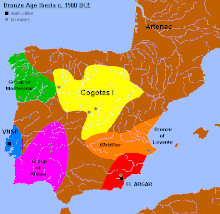
Back ثقافة أرغارية Arabic Cultura d'El Argar Catalan El-Argar-Kultur German Cultura argárica Spanish Kultura argarikoa Basque Culture d'El Argar French Cultura di El Argar Italian El Argarcultuur Dutch Kultura El Argar Polish Cultura argárica Portuguese
 | |
| Geographical range | Southeast Spain |
|---|---|
| Period | Bronze Age |
| Dates | c. 2200 — c. 1300 BC |
| Major sites | El Argar, La Bastida de Totana |
| Preceded by | Bell Beaker culture, Millaran culture |
| Followed by | Motillas, Levantine Bronze Age, Post-Argar, Cogotas culture |
| Bronze Age |
The Argaric culture, named from the type site El Argar near the town of Antas, in what is now the province of Almería in southeastern Spain, is an Early Bronze Age culture which flourished between c. 2200 BC and 1550 BC.[1]
The Argaric culture was characterised by its early adoption of bronze, which briefly allowed this tribe local dominance over other, Copper Age peoples.[2] El Argar also developed sophisticated pottery and ceramic techniques, which they traded with other Mediterranean tribes.
The center of this civilization is displaced to the north and its extension and influence is clearly greater than that of its ancestor. Their mining and metallurgy were quite advanced, with bronze, silver and gold being mined and worked for weapons and jewelry.
Pollen analysis in a peat deposit in the Cañada del Gitano basin high in the Sierra de Baza suggests that the Argaric exhausted precious natural resources, helping bring about its own ruin.[3] The deciduous oak forest that covered the region's slopes were burned off, leaving a tell-tale carbon layer, and replaced by the fire-tolerant, and fire-prone, Mediterranean scrub familiar under the names garrigue and maquis.[4][5]
- ^ Lull, Vicente; R. Micó; Cristina Rihuete Herrada; Roberto Risch (2011). "El Argar and the Beginning of Class Society in the Western Mediterranean". Archäologie in Eurasien. 24: 381–414.
- ^ Lull, Vincente; R. Micó; Cristina Rihuete Herrada; Roberto Risch (2013). Bronze Age Iberia. Oxford University Press. pp. 594–616. ISBN 9780199572861.
{{cite book}}:|journal=ignored (help) - ^ C. Michael Hogan, Los Silillos, the Megaltihic Portal, ed. Andy Burnham
- ^ BBC News, "Eco-ruin 'felled early society'" 15 November 2007.
- ^ Carrión, J.S.; Fuentes, N.; González-Sampériz, P.; Quirante, L. Sánchez; Finlayson, J.C.; Fernández, S.; Andrade, A. (2007). "Holocene environmental change in a montane region of southern Europe with a long history of human settlement". Quaternary Science Reviews. 26 (11–12): 1455–1475. Bibcode:2007QSRv...26.1455C. doi:10.1016/j.quascirev.2007.03.013.